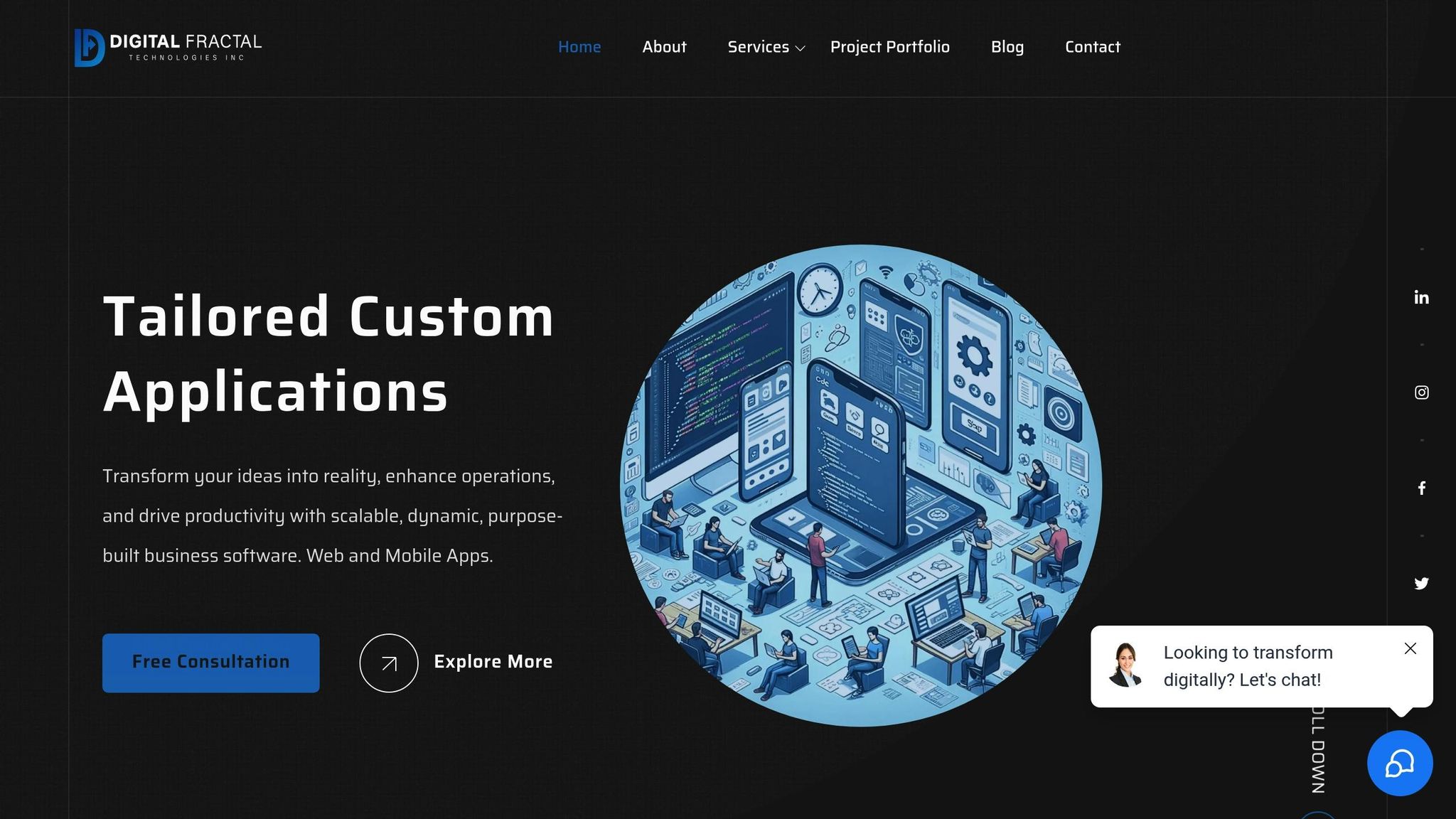
Mobile App vs Web App: Which to Build?
Choosing between a mobile app and a web app depends on your business goals, budget, and user needs. Here’s a quick breakdown:
- Mobile Apps: Ideal for deeper user engagement, offline functionality, and leveraging device-specific features like GPS and push notifications. They offer better performance but come with higher development costs and maintenance needs.
- Web Apps: Accessible on any browser, easier to develop and update, and more cost-effective. Perfect for reaching a broader audience or managing workflows but may lack the advanced features of mobile apps.
Key Considerations for Canadian Businesses:
- Regulations: Sectors like healthcare and finance must comply with privacy laws like PIPEDA.
- Geography: Rural areas may favour mobile apps (offline access), while urban users often prefer web apps.
- Costs: Mobile apps are costlier upfront and for ongoing updates, while web apps are cheaper and quicker to deploy.
Quick Comparison:
| Factor | Mobile Apps | Web Apps |
|---|---|---|
| Development | Higher cost, platform-specific | Lower cost, single codebase |
| Updates | App store approval required | Instant updates |
| Offline Access | Strong offline functionality | Limited offline capabilities |
| User Engagement | Higher retention and interaction | Easier access but lower engagement |
| Scalability | Slower, platform-dependent | Faster, browser-based |
Your choice should align with your business goals, audience needs, and technical constraints. Mobile apps excel in engagement and performance, while web apps prioritize accessibility and cost-efficiency.
Web App vs Mobile App: Which One to Build?
Key Differences: Platform, Access, and Development
Understanding how these differences play out can help Canadian businesses make smarter decisions about resource management, development timelines, and reaching their audience effectively.
Platform-Specific vs. Cross-Platform Development
Mobile app development typically demands separate efforts for each platform. For iOS, developers rely on Swift or Objective-C, while Android apps are built using Java or Kotlin. This often means Canadian businesses must either hire specialists for each platform or invest in training their existing teams, which can stretch budgets and resources.
The costs can add up quickly. Developing a mobile app for both iOS and Android essentially doubles the time and expense. For a Canadian startup with limited funds, it might make more sense to focus on one platform initially and expand later. The downside? This approach risks missing out on a significant portion of the target audience right from the start.
Web apps, on the other hand, follow a universal approach. Technologies like HTML, CSS, and JavaScript allow a single codebase to work seamlessly across devices – whether it’s an iPhone, Android phone, tablet, or desktop computer. This is a major advantage for Canadian businesses that cater to diverse markets, from urban tech hubs to rural communities with different device preferences.
Adding to this, Canada’s talent pool leans heavily toward web developers. While finding skilled iOS or Android developers can be tough – and pricey – in smaller Canadian cities, web development expertise is more widely available across the country. This makes the unified codebase approach even more appealing.
Now, let’s explore how these differences impact user access and engagement.
Access and Usage Scenarios
How users access your application has a direct impact on their experience and your business potential. Mobile apps require users to discover, download, and install them through app stores. While this process creates some friction, it also fosters a deeper commitment from users.
App store discovery is a double-edged sword for Canadian businesses. On one hand, your app competes with millions of others for attention. On the other, successful apps can benefit from app store marketing and recommendation algorithms. Once installed, users are dedicating device storage to your app, which often signals a higher level of interest and engagement. This dynamic is crucial when planning user acquisition and retention strategies.
Web apps, by contrast, offer instant access through any browser. Users can find your app via search engines, social media, or direct links – no downloads or installations required. This frictionless entry is particularly useful for Canadian businesses targeting occasional users or those hesitant to install new apps.
For users in areas with inconsistent internet connectivity, offline functionality becomes a key factor. Mobile apps excel here, making them ideal for Canadians who frequently travel between urban centres and rural regions. For example, a mobile banking app lets users check balances or view transactions during a camping trip in Algonquin Park. Meanwhile, a web-based project management tool would require a steady internet connection, limiting its usefulness in such scenarios. These considerations are pivotal for aligning business goals with user needs across Canada’s varied geography.
Development Time and Complexity
Development timelines are a critical factor for Canadian businesses, especially those operating under seasonal pressures or facing stiff competition. Mobile app development tends to take longer due to platform-specific requirements, app store approvals, and extensive multi-device testing.
The complexity doesn’t end with development. Mobile apps must be optimized for various screen sizes, operating system versions, and hardware capabilities. Testing across the wide range of Android devices alone can add weeks to the timeline. On top of that, app store reviews introduce further delays. While Google Play reviews are relatively quick, Apple’s App Store can take several days – or even weeks – for approvals. Businesses planning time-sensitive launches must account for these potential setbacks.
Web apps, in contrast, offer faster deployment cycles. Updates and changes can be rolled out instantly without waiting for app store approval. This agility is particularly advantageous for Canadian businesses in fast-paced industries like e-commerce during the holiday rush or financial services adapting to new regulations.
That said, web apps come with their own challenges. Ensuring consistent performance across browsers and devices requires careful testing. While compatibility with outdated browsers like Internet Explorer is less of a concern today, some Canadian government agencies and enterprises still rely on older systems, adding to the complexity.
Maintenance needs also differ. Mobile apps require frequent updates to align with new operating system versions, security patches, and feature enhancements. Each update must go through the app store approval process. Web apps, however, can be updated instantly, though they must maintain backward compatibility and handle varying internet speeds – a critical consideration given Canada’s vast and diverse geography. For businesses juggling regulatory requirements and market demands, these timing differences can be a deciding factor.
Performance, User Experience, and Engagement
When it comes to driving user engagement, nothing beats top-notch app performance and a user-friendly design – two factors that Canadian businesses can’t afford to overlook. The way mobile and web apps perform directly impacts how satisfied users feel, which in turn influences engagement and retention across the country.
Performance and Speed
Mobile apps, by taking advantage of native hardware and local storage, deliver impressive results: 157% higher conversion rates and 4.2 times more product views compared to other platforms. For Canadian e-commerce businesses, this isn’t just a stat – it’s a revenue booster.
On the flip side, web apps rely heavily on internet connectivity and browser capabilities. In urban areas with reliable high-speed internet, this might not be a big issue. But for businesses serving rural or northern communities, where connectivity can be spotty, web apps often struggle to perform consistently. Mobile apps, with their offline capabilities, shine in these scenarios, letting users access key services even when the internet is down. This not only speeds up transactions but also makes the overall experience more reliable and satisfying.
User Experience and Interaction
Mobile apps deliver a more immersive and interactive experience by integrating with device features like cameras, GPS, biometric authentication, and even haptic feedback. These are things web apps simply can’t replicate. Push notifications are another powerful tool in the mobile app arsenal, boasting 20% open rates and 28% click-through rates, compared to email’s much lower 2.1% and 1%.
Web apps, however, win when it comes to accessibility. They work across all devices without requiring downloads or updates, making them a great choice for reaching a broad audience, including older Canadians or those with limited storage on their devices. Plus, web apps benefit from well-established accessibility standards and built-in assistive tools, ensuring they’re user-friendly for everyone.
User Engagement and Retention
The combination of sleek interfaces and smooth functionality makes mobile apps a retention powerhouse. Canadians spend an average of 4.5 hours daily on mobile apps, with usage climbing 20% in the last two years. Interestingly, 90% of mobile internet time is spent within apps rather than browsers. Preferences back this up: 70% of users prefer app experiences over websites, and 57% use brand apps, compared to 44% who stick with websites.
Mobile apps also deliver three times higher conversion rates than mobile websites. While web apps make it easy for users to jump in – thanks to their instant accessibility via search engines, social media links, or direct URLs – they often struggle to keep users engaged long-term. Without features like push notifications or offline functionality, web apps can lose their audience over time. They’re great for drawing in new customers, but mobile apps are better at building lasting, more profitable relationships.
The stakes are high when it comes to digital experiences. Poor performance can drive users straight into a competitor’s arms: 58% of consumers have switched brands due to bad digital experiences, and 51% have stopped using services altogether because of frustrations with apps or websites.
sbb-itb-fd1fcab
Development Costs, Maintenance, and Growth
Budget planning is at the heart of any successful app project. For Canadian businesses, it’s crucial to account for ongoing expenses like development, maintenance, updates, and scaling. Here’s a closer look at how these costs stack up for mobile and web apps.
Development and Maintenance Costs
Mobile apps often come with a steeper upfront cost. Developing native apps for iOS and Android essentially means building two separate products, each requiring its own set of resources and expertise. This dual-platform approach can quickly drive up development time and expenses.
Web apps, by contrast, are generally more budget-friendly to start. Since you’re creating a single application that works across all browsers and devices, the development process is usually simpler and faster.
Once your app is live, ongoing costs start to add up. Mobile apps bring additional expenses like app store fees and frequent updates to remain compatible with new operating systems. Web apps sidestep app store fees but require investment in hosting solutions, such as CDNs, to manage traffic and maintain performance. Security is another key factor – regular updates, patches, and SSL certificate renewals are essential, especially for adhering to Canadian privacy laws like PIPEDA. These upfront differences in cost can significantly shape the financial trajectory of your app.
Scalability and Long-Term Growth
Beyond development and maintenance, scalability is another area where mobile and web apps diverge. Web apps shine when it comes to scaling and rolling out updates. New features can be deployed instantly, and users automatically access the latest version when they visit your site. This makes web apps an excellent choice for businesses that need to adapt quickly to market trends or seasonal changes.
Mobile apps, however, face more hurdles. Updates often require app store approvals, and users must manually download the latest version. This lag can leave some users on outdated versions, potentially affecting their experience.
Expanding across Canada further highlights these differences. Web apps can immediately reach new regions without major adjustments. Mobile apps, on the other hand, may need additional planning to handle varying network conditions and device capabilities. They also tend to accumulate technical debt, as ongoing compatibility testing across a wide range of devices and operating systems becomes necessary. Web apps, however, generally face fewer challenges with browser compatibility.
Cost and Scalability Comparison Table
Here’s a quick comparison of the cost and scalability factors for mobile and web apps:
| Factor | Mobile Apps | Web Apps |
|---|---|---|
| Initial Development | Higher upfront costs for platform-specific coding | Lower costs with a single development cycle |
| Annual Maintenance | Includes OS updates and app store fees | Focused on hosting and security updates |
| Platform Fees | App store fees apply | Hosting infrastructure costs |
| Update Deployment | Requires app store approval | Instant deployment with automatic updates |
| Update Adoption | Users must manually update | Automatic updates for all users |
| Geographic Scaling | Requires adjustments for regional differences | Easily scales across regions |
| Long-term Flexibility | Limited by OS and device compatibility | More adaptable to changing business needs |
For Canadian businesses planning long-term growth, these distinctions are critical. Mobile apps often come with higher upfront and ongoing costs, while web apps provide a more consistent and manageable cost structure over time.
Choosing the Right Solution: Business Goals and Technical Needs
Deciding between mobile and web apps is about aligning your digital strategy with your business objectives. Canadian businesses, in particular, face unique challenges – from regulatory requirements to serving diverse geographic markets across the country. Below, we’ll explore how your business goals and technical needs can guide you to the right platform.
Matching Business Goals
Your app choice should always be driven by your business goals. For example, if your focus is on deep user engagement – think loyalty programs or apps designed for daily use – mobile apps are often the better fit. They offer features like push notifications, access to device tools, and offline functionality, all of which help keep users engaged.
On the other hand, if operational efficiency is your goal, web apps are typically more practical. They’re ideal for streamlining internal processes, managing workflows, or providing employees with access across different devices. Plus, web apps allow for instant updates, ensuring everyone is always using the latest version without the hassle of managing app updates on individual devices.
For businesses aiming to reach a broad audience, web apps often win out due to their ease of access. Unlike mobile apps, which depend on device adoption rates – something that can vary between urban centres like Toronto and Vancouver and more rural areas – web apps are universally accessible through any browser.
Revenue models also play a role. Subscription services often pair well with web apps because of simpler payment processing and fewer restrictions. However, businesses that rely on in-app purchases, like product-based companies, may benefit from the ecosystems provided by mobile app stores, even though these come with platform fees.
Technical Requirements and Constraints
The technical side of things can also heavily influence your decision. Device compatibility is one key factor. If your users are primarily working on desktop computers – common in fields like professional services or government – a web app is likely the better choice. In contrast, industries like construction or energy, where employees are often in the field, may require mobile-first solutions.
Internet connectivity is another major consideration, especially for businesses serving remote regions of Canada. For example, mining operations in Northern Ontario or forestry work in British Columbia often face unreliable or limited connectivity. In these cases, mobile apps with offline functionality are critical, whereas web apps, which rely on a constant internet connection, may not be suitable.
Regulatory compliance is another area where web apps can have an edge. Meeting Canadian privacy and data residency requirements is often more straightforward with web apps, as you have direct control over hosting and data storage. Mobile apps, however, face additional challenges around data collection and user consent, especially when accessing device features.
Accessibility requirements under the Accessible Canada Act also influence platform choice. Web apps can leverage well-established accessibility standards like WCAG, while mobile apps must account for platform-specific accessibility features. This is especially important for public sector projects, where accessibility mandates are particularly strict.
Finally, integration with existing systems can dictate which platform makes more sense. Web apps tend to offer more flexibility when connecting to enterprise software, databases, or third-party services. Mobile apps, by comparison, may require additional middleware or face limitations when integrating with legacy systems. These factors not only affect the functionality of your app but also influence project timelines and costs.
Digital Fractal Technologies Inc Solutions

Digital Fractal Technologies Inc understands the unique challenges that Canadian businesses face and offers tailored solutions to meet these needs. Their approach to custom mobile and web app development focuses on aligning technology choices with business goals rather than offering generic, one-size-fits-all solutions.
For public sector clients, they prioritise compliance-first development. This ensures that applications meet data sovereignty and accessibility standards from the outset. With expertise in government workflows, they can determine whether citizen-facing services are better suited to accessible web platforms or feature-rich mobile apps for field operations.
In the energy sector, where safety and operational efficiency are critical, Digital Fractal Technologies Inc builds mobile apps with offline capabilities and web dashboards for centralised monitoring. These solutions address the connectivity challenges and harsh environments often encountered in this industry.
For the construction industry, they offer solutions designed for project-based workflows and multi-stakeholder coordination. By combining mobile apps for on-site data collection with web platforms for project management and reporting, they create tools that work seamlessly across job sites, offices, and client locations.
Their AI consulting services add another layer to the decision-making process. Whether it’s machine learning, computer vision, or automated workflows, Digital Fractal Technologies Inc helps businesses understand how AI capabilities can be implemented across platforms, ensuring scalability and long-term value.
Additionally, their workflow automation expertise ensures that app development is seamlessly integrated into broader digital transformation initiatives. Instead of treating the mobile-versus-web decision in isolation, they focus on how the platform will interact with existing tools like CRM systems and operational processes.
What sets Digital Fractal Technologies Inc apart is their dedication to creating purpose-built applications. They work closely with Canadian businesses to understand not just what they want to build, but why. This ensures that the chosen platform supports long-term objectives, rather than just addressing short-term technical needs. Their tailored approach reflects the strategic considerations outlined above, ensuring that each solution meets both business and technical requirements.
Conclusion: Making the Right Choice for Your Business
As discussed, choosing between a mobile app and a web app is a strategic decision that should align closely with your business objectives. This choice impacts how your operations run, how you connect with customers, and ultimately, how your business grows. For Canadian businesses, the decision carries added weight due to challenges like serving a geographically diverse market and meeting strict regulatory standards.
Key Points for Decision-Makers
Mobile and web apps each bring unique strengths to different business scenarios. Mobile apps stand out for their ability to drive user engagement and loyalty. They’re particularly useful for businesses that rely on frequent customer interactions, loyalty programs, or field operations in areas where connectivity may be unreliable.
On the other hand, web apps focus on accessibility and streamlined efficiency. They avoid the delays of app store approvals, allow instant updates for all users, and integrate smoothly with existing systems. This makes them a practical choice for businesses targeting a broad audience or those needing frequent updates.
Costs go beyond just the initial development. Mobile apps, while offering high potential returns through better user engagement, require ongoing maintenance across platforms and compliance with app store guidelines. Meanwhile, web apps typically have lower maintenance demands but may not deliver the same level of user engagement.
When it comes to performance and user experience, mobile apps often provide faster, more intuitive interactions, especially for consumer-facing applications. Web apps, however, ensure consistency across devices and avoid compatibility issues that can sometimes arise in mobile development.
Aligning your choice with your business goals is key. Research highlights that when software architecture supports business objectives, it becomes a tool for improving efficiency, optimizing resources, and adapting quickly to market changes. Scalability also plays a critical role, influencing user satisfaction, business growth, and cost management over the long term.
Next Steps for Your Business
To move forward with confidence, evaluate your business model, audience, and growth goals. Take a close look at your customer journey to understand how people interact with your products or services. Assess your current resources and your ability to manage ongoing maintenance. Additionally, ensure that your chosen solution integrates well with your existing systems to maintain smooth data flow as your business expands.
Digital Fractal Technologies Inc specializes in helping businesses navigate these decisions. Whether you’re addressing compliance in the public sector, managing fieldwork in the energy industry, or coordinating complex projects in construction, expert advice can ensure your technology choice supports sustainable growth.
The decision between a mobile app and a web app will shape your digital strategy for years to come. Take the time to define your goals, understand your technical needs, and consult experienced developers familiar with the Canadian market. The choice you make today will lay the foundation for your future success.
FAQs
What should Canadian businesses consider when deciding between a mobile app and a web app?
When choosing between a mobile app and a web app, Canadian businesses need to weigh their target audience, business objectives, and technical needs. Mobile apps often deliver faster performance, offline capabilities, and a smooth native experience, which can boost user engagement and loyalty. In contrast, web apps are generally more affordable to build and maintain, while being accessible across various devices without requiring downloads.
Important factors to consider include development costs, adherence to Canadian privacy laws like PIPEDA, and your users’ specific preferences. For instance, if your audience prioritizes convenience and offline functionality, a mobile app might be the way to go. On the other hand, if accessibility and budget constraints are more pressing, a web app could be a better fit. By aligning your choice with your business goals and current market trends, you can determine which app type best meets your needs.
What are the differences in development costs and maintenance between mobile apps and web apps for Canadian businesses?
For businesses in Canada, mobile apps often come with a heftier price tag. Development costs can range from $40,000 to $540,000 CAD, depending on how complex the app is. On top of that, annual maintenance – covering things like platform updates and app store fees – typically runs about 15–20% of the original development cost.
In contrast, web apps are generally a more affordable option. Development costs usually fall between $15,000 and $80,000 CAD, and maintenance expenses are lower since web apps don’t require updates tailored to specific platforms. This makes them a more economical choice, especially for businesses looking for long-term scalability.
In summary, mobile apps deliver a more customised user experience but come with higher costs. Meanwhile, web apps are a budget-friendly alternative that’s easier to maintain, perfect for businesses focusing on cost efficiency.
What makes mobile apps better for user engagement and offline access compared to web apps?
Mobile apps stand out when it comes to user engagement, thanks to features like real-time notifications, tailored experiences, and seamless interactions. These tools keep users connected and more involved, offering a level of interaction that web apps often can’t match.
Another key benefit is their offline functionality. Mobile apps allow users to access saved data and complete tasks even without an internet connection. This kind of reliability boosts user satisfaction and ensures the app remains useful, even in areas where connectivity is spotty. These strengths make mobile apps an appealing option for businesses that value strong engagement and accessibility.

